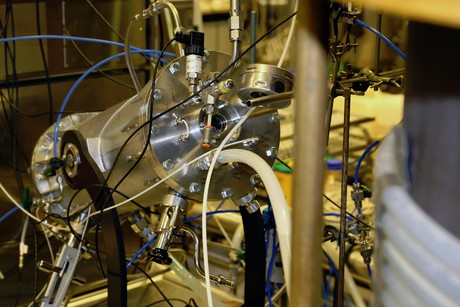Creating food from electricity

Feeding the world would be vastly easier if food could be produced from air and electricity alone. In a joint project, researchers from Lappeenranta University of Technology (LUT) and the VTT Technical Research Centre of Finland produced a batch of single-cell protein in this way.
The method releases food production from restrictions related to the environment, as the protein can be produced anywhere renewable energy, such as solar energy, is available. The protein produced in this way can be further developed for use as food and animal feed.
“In practice, all the raw materials are available from the air. In the future, the technology can be transported to, for instance, deserts and other areas facing famine. One possible alternative is a home reactor, a type of domestic appliance that the consumer can use to produce the needed protein,” explained Juha-Pekka Pitkänen, principal scientist at VTT.
Along with food, the researchers are developing the protein to be used as animal feed. The protein created with electricity can be used as a fodder replacement, thus releasing land areas for other purposes, such as forestry. It allows food to be produced where it is needed.
“Compared to traditional agriculture, the production method currently under development does not require a location with the conditions for agriculture, such as the right temperature, humidity or a certain soil type. This allows us to use a completely automatised process to produce the animal feed required in a shipping container facility built on the farm. The method requires no pest-control substances. Only the required amount of fertiliser-like nutrients is used in the closed process. This allows us to avoid any environmental impacts, such as run-offs into water systems or the formation of powerful greenhouse gases,” said Professor Jero Ahola of LUT.
10-fold energy efficiency
According to estimates by the researchers, the process of creating food from electricity can be nearly 10 times as energy efficient as common photosynthesis, which is used for cultivation of soy and other products. For the product to be competitive, the production process must become even more efficient. Currently, the production of one gram of protein takes around two weeks, using laboratory equipment that is about the size of a coffee cup.
The next step the researchers are aiming for is to begin pilot production. At the pilot stage, the material would be produced in quantities sufficient for the development and testing of fodder and food products. This would also allow commercialisation to be done.
“We are currently focusing on developing the technology: reactor concepts, technology, improving efficiency and controlling the process. Control of the process involves adjustment and modelling of renewable energy so as to enable the microbes to grow as well as possible. The idea is to develop the concept into a mass product, with a price that drops as the technology becomes more common. The schedule for commercialisation depends on the economy,” Ahola stated.
50% protein
“In the long term, protein created with electricity is meant to be used in cooking and products as it is. The mixture is very nutritious, with more than 50% protein and 25% carbohydrates. The rest is fats and nucleic acids. The consistency of the final product can be modified by changing the organisms used in the production,” Pitkänen explained.
The study is part of the wide-ranging Neo-Carbon Energy research project, carried out jointly by the LUT and VTT. The aim of the project is to develop an energy system that is completely renewable and emission-free. The Food from Electricity study is funded by the Academy of Finland and runs for four years.
Nestlé's personal pet food solutions
Nestlé has launched the Petivity Microbiome Analysis Kit, an ecosystem of smart devices...
NSW subsidies available to showcase at Fine Food Australia
Up to 12 food and beverage manufacturers across NSW could be eligible to receive government...
Families facing back to school lunchbox pinch
A study has found that families can face a pinch when packing a school lunchbox, spending about...












